Health Program Planning, Monitoring and Evaluation Report
VerifiedAdded on 2023/06/09
|9
|2611
|50
Report
AI Summary
This report addresses key aspects of health program planning, monitoring, and evaluation. It begins by outlining effective strategies to enhance health promotion, including advocacy, enabling, and mediation, while also identifying potential barriers like social norms and limited resources. The report then delves into the core components of health plans—issues, populations, and settings—providing detailed examples for each. A significant portion is dedicated to community needs assessment, emphasizing its critical role in successful program implementation, detailing various need types (felt, expressed, and agency-determined) and collection methods. Finally, the report analyzes a specific health problem, smoking in Australia, critically assessing planning and implementation gaps and proposing improvements, including interventions like awareness campaigns and tax increases, and discusses the progress and gaps in the Australian context.
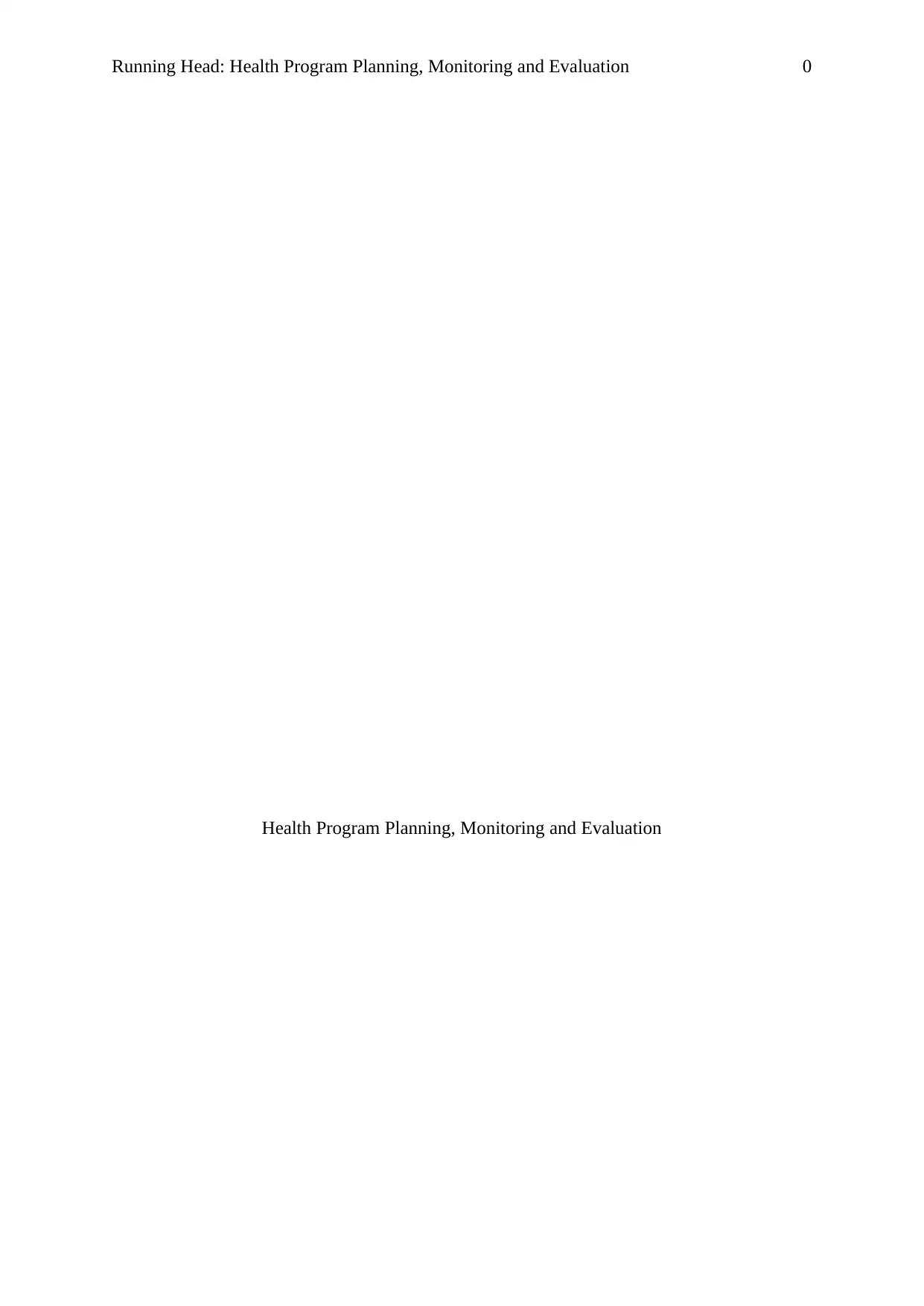
Running Head: Health Program Planning, Monitoring and Evaluation 0
Health Program Planning, Monitoring and Evaluation
Health Program Planning, Monitoring and Evaluation
Paraphrase This Document
Need a fresh take? Get an instant paraphrase of this document with our AI Paraphraser
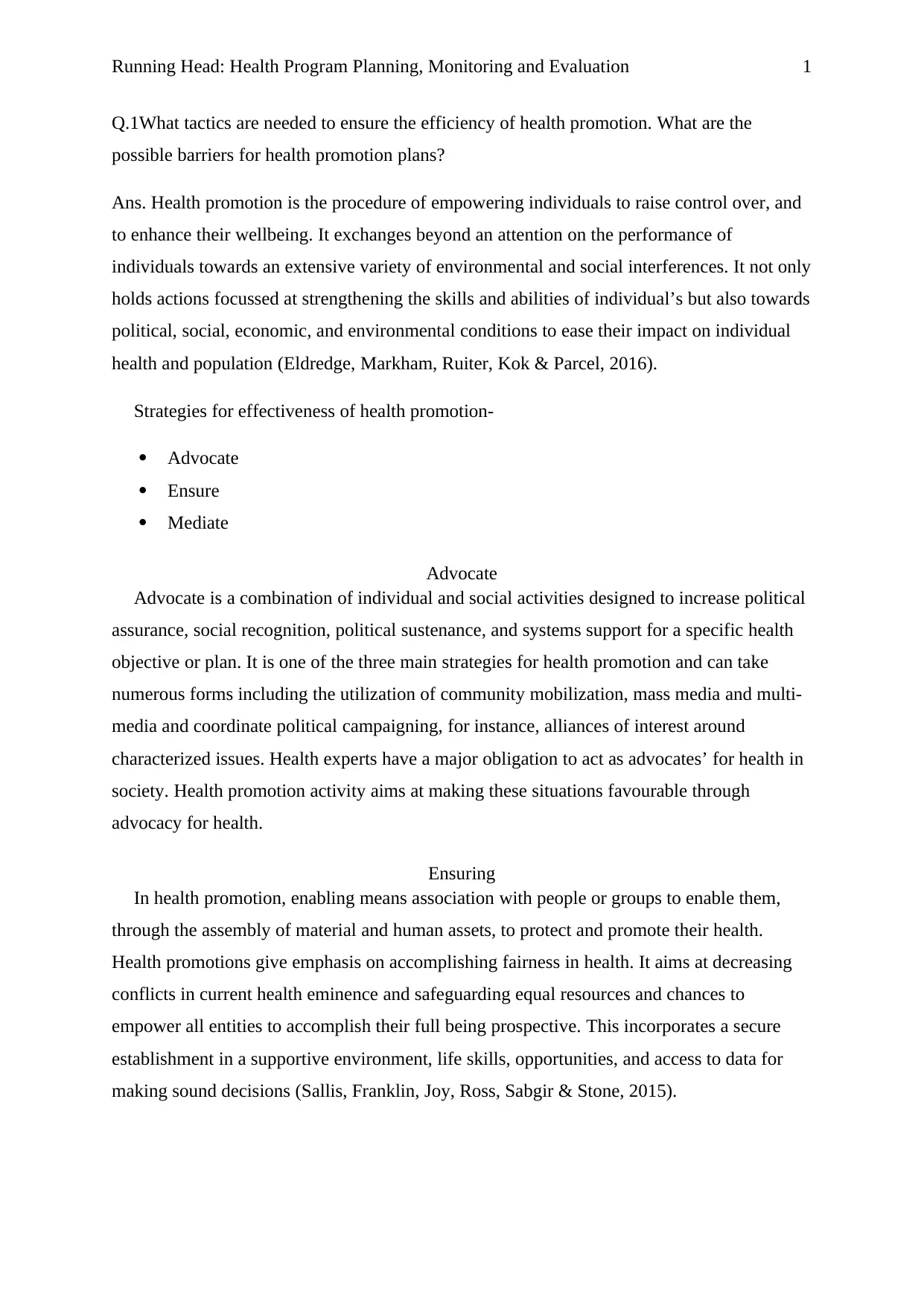
Running Head: Health Program Planning, Monitoring and Evaluation 1
Q.1What tactics are needed to ensure the efficiency of health promotion. What are the
possible barriers for health promotion plans?
Ans. Health promotion is the procedure of empowering individuals to raise control over, and
to enhance their wellbeing. It exchanges beyond an attention on the performance of
individuals towards an extensive variety of environmental and social interferences. It not only
holds actions focussed at strengthening the skills and abilities of individual’s but also towards
political, social, economic, and environmental conditions to ease their impact on individual
health and population (Eldredge, Markham, Ruiter, Kok & Parcel, 2016).
Strategies for effectiveness of health promotion-
Advocate
Ensure
Mediate
Advocate
Advocate is a combination of individual and social activities designed to increase political
assurance, social recognition, political sustenance, and systems support for a specific health
objective or plan. It is one of the three main strategies for health promotion and can take
numerous forms including the utilization of community mobilization, mass media and multi-
media and coordinate political campaigning, for instance, alliances of interest around
characterized issues. Health experts have a major obligation to act as advocates’ for health in
society. Health promotion activity aims at making these situations favourable through
advocacy for health.
Ensuring
In health promotion, enabling means association with people or groups to enable them,
through the assembly of material and human assets, to protect and promote their health.
Health promotions give emphasis on accomplishing fairness in health. It aims at decreasing
conflicts in current health eminence and safeguarding equal resources and chances to
empower all entities to accomplish their full being prospective. This incorporates a secure
establishment in a supportive environment, life skills, opportunities, and access to data for
making sound decisions (Sallis, Franklin, Joy, Ross, Sabgir & Stone, 2015).
Q.1What tactics are needed to ensure the efficiency of health promotion. What are the
possible barriers for health promotion plans?
Ans. Health promotion is the procedure of empowering individuals to raise control over, and
to enhance their wellbeing. It exchanges beyond an attention on the performance of
individuals towards an extensive variety of environmental and social interferences. It not only
holds actions focussed at strengthening the skills and abilities of individual’s but also towards
political, social, economic, and environmental conditions to ease their impact on individual
health and population (Eldredge, Markham, Ruiter, Kok & Parcel, 2016).
Strategies for effectiveness of health promotion-
Advocate
Ensure
Mediate
Advocate
Advocate is a combination of individual and social activities designed to increase political
assurance, social recognition, political sustenance, and systems support for a specific health
objective or plan. It is one of the three main strategies for health promotion and can take
numerous forms including the utilization of community mobilization, mass media and multi-
media and coordinate political campaigning, for instance, alliances of interest around
characterized issues. Health experts have a major obligation to act as advocates’ for health in
society. Health promotion activity aims at making these situations favourable through
advocacy for health.
Ensuring
In health promotion, enabling means association with people or groups to enable them,
through the assembly of material and human assets, to protect and promote their health.
Health promotions give emphasis on accomplishing fairness in health. It aims at decreasing
conflicts in current health eminence and safeguarding equal resources and chances to
empower all entities to accomplish their full being prospective. This incorporates a secure
establishment in a supportive environment, life skills, opportunities, and access to data for
making sound decisions (Sallis, Franklin, Joy, Ross, Sabgir & Stone, 2015).
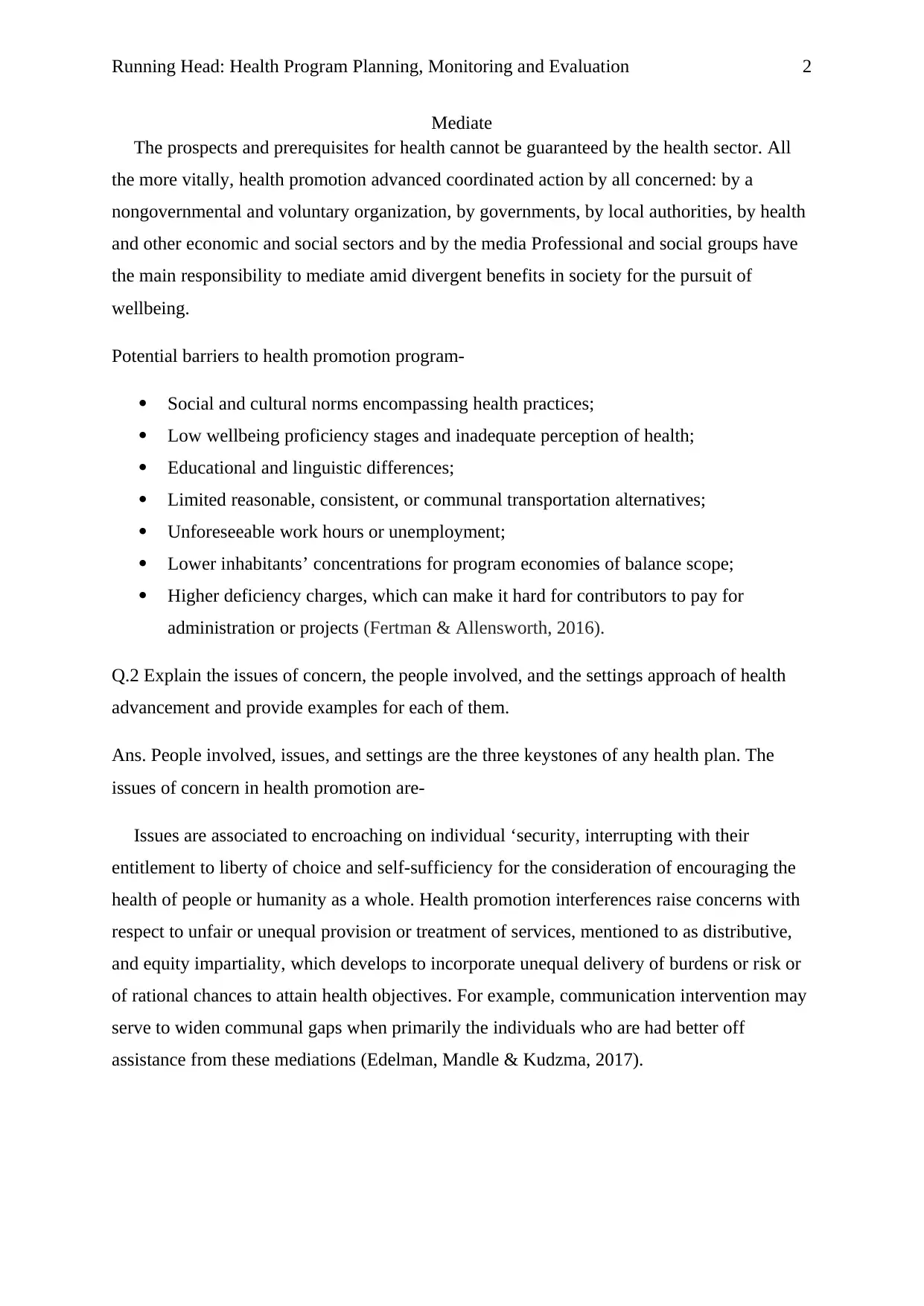
Running Head: Health Program Planning, Monitoring and Evaluation 2
Mediate
The prospects and prerequisites for health cannot be guaranteed by the health sector. All
the more vitally, health promotion advanced coordinated action by all concerned: by a
nongovernmental and voluntary organization, by governments, by local authorities, by health
and other economic and social sectors and by the media Professional and social groups have
the main responsibility to mediate amid divergent benefits in society for the pursuit of
wellbeing.
Potential barriers to health promotion program-
Social and cultural norms encompassing health practices;
Low wellbeing proficiency stages and inadequate perception of health;
Educational and linguistic differences;
Limited reasonable, consistent, or communal transportation alternatives;
Unforeseeable work hours or unemployment;
Lower inhabitants’ concentrations for program economies of balance scope;
Higher deficiency charges, which can make it hard for contributors to pay for
administration or projects (Fertman & Allensworth, 2016).
Q.2 Explain the issues of concern, the people involved, and the settings approach of health
advancement and provide examples for each of them.
Ans. People involved, issues, and settings are the three keystones of any health plan. The
issues of concern in health promotion are-
Issues are associated to encroaching on individual ‘security, interrupting with their
entitlement to liberty of choice and self-sufficiency for the consideration of encouraging the
health of people or humanity as a whole. Health promotion interferences raise concerns with
respect to unfair or unequal provision or treatment of services, mentioned to as distributive,
and equity impartiality, which develops to incorporate unequal delivery of burdens or risk or
of rational chances to attain health objectives. For example, communication intervention may
serve to widen communal gaps when primarily the individuals who are had better off
assistance from these mediations (Edelman, Mandle & Kudzma, 2017).
Mediate
The prospects and prerequisites for health cannot be guaranteed by the health sector. All
the more vitally, health promotion advanced coordinated action by all concerned: by a
nongovernmental and voluntary organization, by governments, by local authorities, by health
and other economic and social sectors and by the media Professional and social groups have
the main responsibility to mediate amid divergent benefits in society for the pursuit of
wellbeing.
Potential barriers to health promotion program-
Social and cultural norms encompassing health practices;
Low wellbeing proficiency stages and inadequate perception of health;
Educational and linguistic differences;
Limited reasonable, consistent, or communal transportation alternatives;
Unforeseeable work hours or unemployment;
Lower inhabitants’ concentrations for program economies of balance scope;
Higher deficiency charges, which can make it hard for contributors to pay for
administration or projects (Fertman & Allensworth, 2016).
Q.2 Explain the issues of concern, the people involved, and the settings approach of health
advancement and provide examples for each of them.
Ans. People involved, issues, and settings are the three keystones of any health plan. The
issues of concern in health promotion are-
Issues are associated to encroaching on individual ‘security, interrupting with their
entitlement to liberty of choice and self-sufficiency for the consideration of encouraging the
health of people or humanity as a whole. Health promotion interferences raise concerns with
respect to unfair or unequal provision or treatment of services, mentioned to as distributive,
and equity impartiality, which develops to incorporate unequal delivery of burdens or risk or
of rational chances to attain health objectives. For example, communication intervention may
serve to widen communal gaps when primarily the individuals who are had better off
assistance from these mediations (Edelman, Mandle & Kudzma, 2017).
⊘ This is a preview!⊘
Do you want full access?
Subscribe today to unlock all pages.

Trusted by 1+ million students worldwide
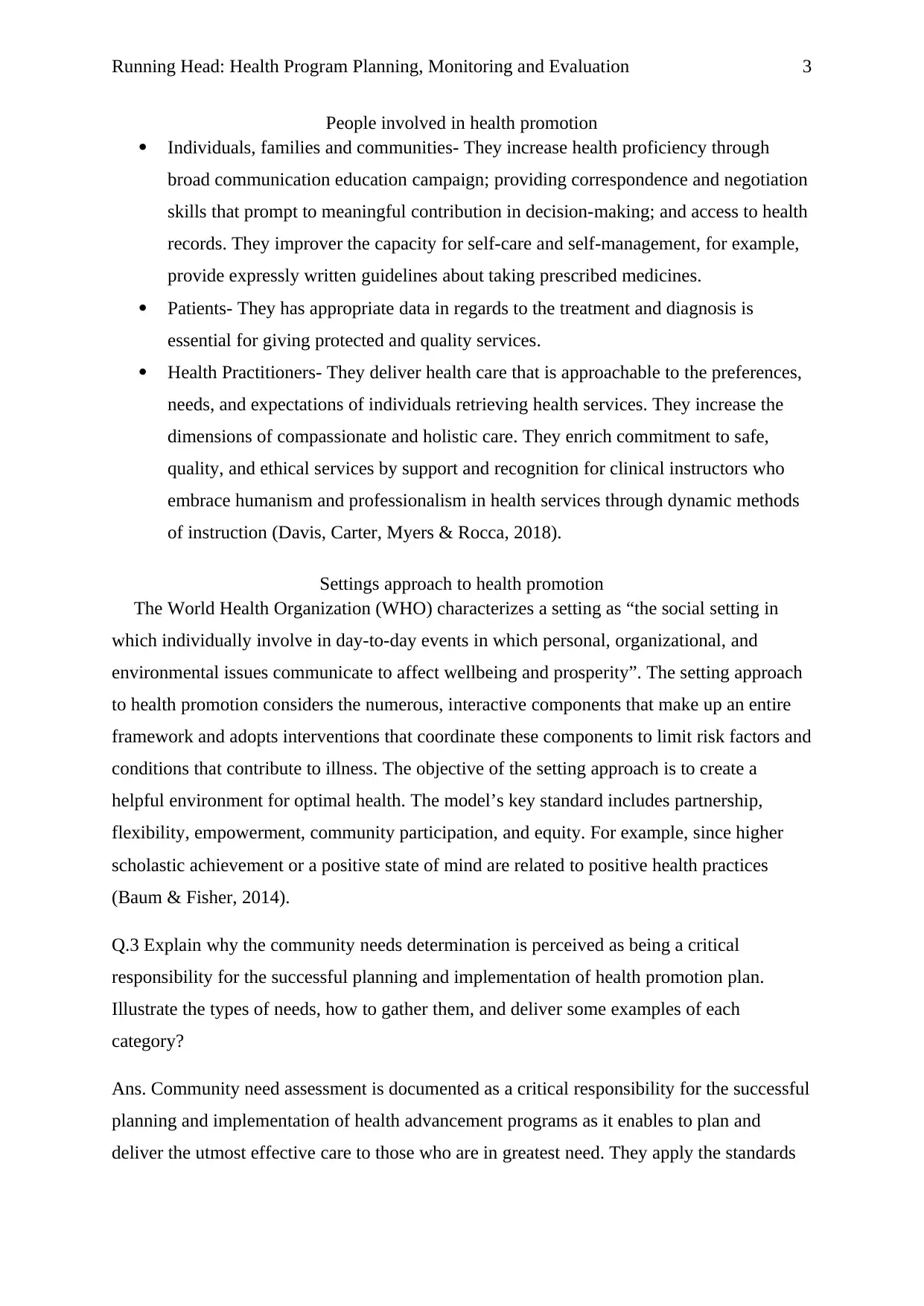
Running Head: Health Program Planning, Monitoring and Evaluation 3
People involved in health promotion
Individuals, families and communities- They increase health proficiency through
broad communication education campaign; providing correspondence and negotiation
skills that prompt to meaningful contribution in decision-making; and access to health
records. They improver the capacity for self-care and self-management, for example,
provide expressly written guidelines about taking prescribed medicines.
Patients- They has appropriate data in regards to the treatment and diagnosis is
essential for giving protected and quality services.
Health Practitioners- They deliver health care that is approachable to the preferences,
needs, and expectations of individuals retrieving health services. They increase the
dimensions of compassionate and holistic care. They enrich commitment to safe,
quality, and ethical services by support and recognition for clinical instructors who
embrace humanism and professionalism in health services through dynamic methods
of instruction (Davis, Carter, Myers & Rocca, 2018).
Settings approach to health promotion
The World Health Organization (WHO) characterizes a setting as “the social setting in
which individually involve in day-to-day events in which personal, organizational, and
environmental issues communicate to affect wellbeing and prosperity”. The setting approach
to health promotion considers the numerous, interactive components that make up an entire
framework and adopts interventions that coordinate these components to limit risk factors and
conditions that contribute to illness. The objective of the setting approach is to create a
helpful environment for optimal health. The model’s key standard includes partnership,
flexibility, empowerment, community participation, and equity. For example, since higher
scholastic achievement or a positive state of mind are related to positive health practices
(Baum & Fisher, 2014).
Q.3 Explain why the community needs determination is perceived as being a critical
responsibility for the successful planning and implementation of health promotion plan.
Illustrate the types of needs, how to gather them, and deliver some examples of each
category?
Ans. Community need assessment is documented as a critical responsibility for the successful
planning and implementation of health advancement programs as it enables to plan and
deliver the utmost effective care to those who are in greatest need. They apply the standards
People involved in health promotion
Individuals, families and communities- They increase health proficiency through
broad communication education campaign; providing correspondence and negotiation
skills that prompt to meaningful contribution in decision-making; and access to health
records. They improver the capacity for self-care and self-management, for example,
provide expressly written guidelines about taking prescribed medicines.
Patients- They has appropriate data in regards to the treatment and diagnosis is
essential for giving protected and quality services.
Health Practitioners- They deliver health care that is approachable to the preferences,
needs, and expectations of individuals retrieving health services. They increase the
dimensions of compassionate and holistic care. They enrich commitment to safe,
quality, and ethical services by support and recognition for clinical instructors who
embrace humanism and professionalism in health services through dynamic methods
of instruction (Davis, Carter, Myers & Rocca, 2018).
Settings approach to health promotion
The World Health Organization (WHO) characterizes a setting as “the social setting in
which individually involve in day-to-day events in which personal, organizational, and
environmental issues communicate to affect wellbeing and prosperity”. The setting approach
to health promotion considers the numerous, interactive components that make up an entire
framework and adopts interventions that coordinate these components to limit risk factors and
conditions that contribute to illness. The objective of the setting approach is to create a
helpful environment for optimal health. The model’s key standard includes partnership,
flexibility, empowerment, community participation, and equity. For example, since higher
scholastic achievement or a positive state of mind are related to positive health practices
(Baum & Fisher, 2014).
Q.3 Explain why the community needs determination is perceived as being a critical
responsibility for the successful planning and implementation of health promotion plan.
Illustrate the types of needs, how to gather them, and deliver some examples of each
category?
Ans. Community need assessment is documented as a critical responsibility for the successful
planning and implementation of health advancement programs as it enables to plan and
deliver the utmost effective care to those who are in greatest need. They apply the standards
Paraphrase This Document
Need a fresh take? Get an instant paraphrase of this document with our AI Paraphraser
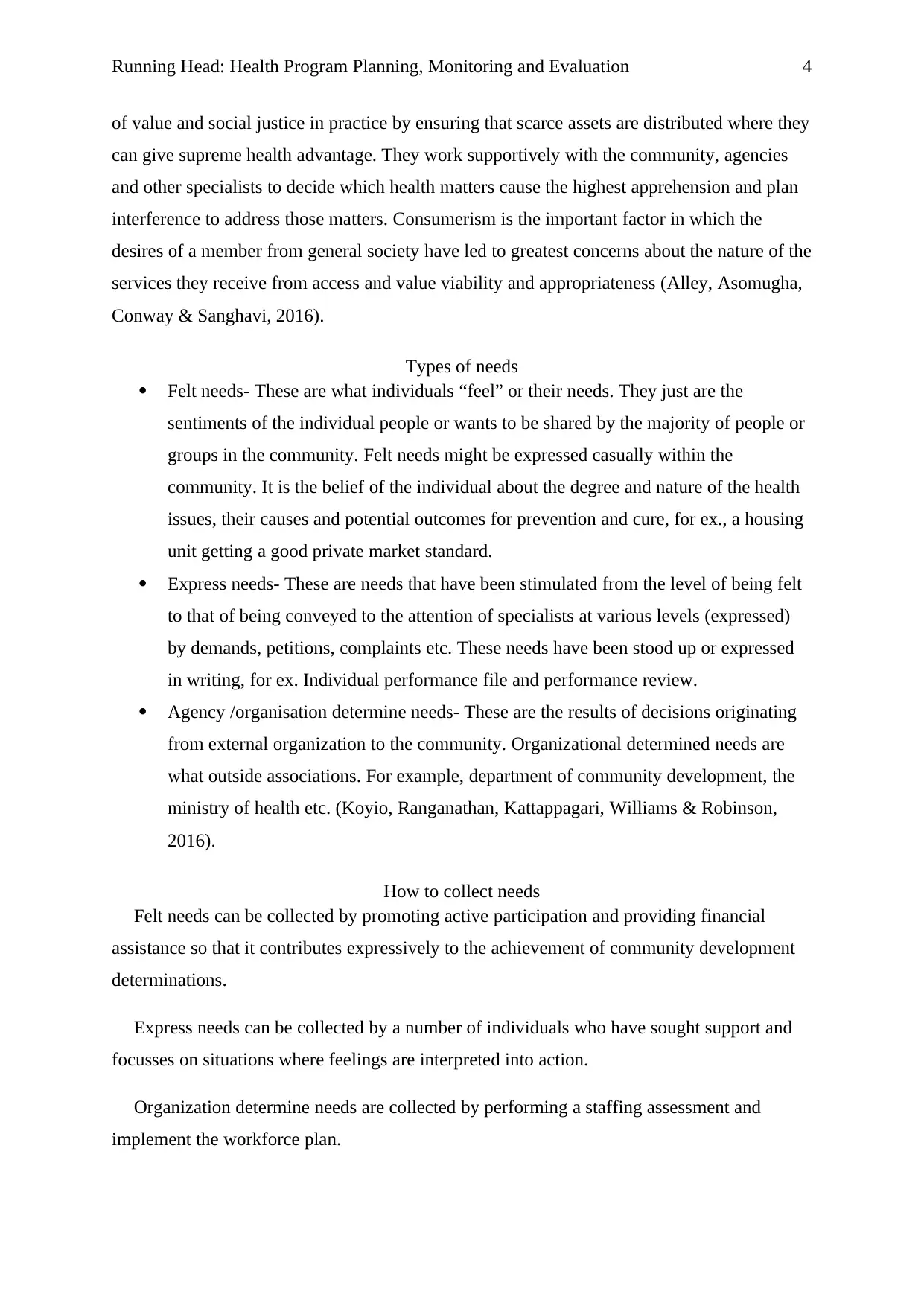
Running Head: Health Program Planning, Monitoring and Evaluation 4
of value and social justice in practice by ensuring that scarce assets are distributed where they
can give supreme health advantage. They work supportively with the community, agencies
and other specialists to decide which health matters cause the highest apprehension and plan
interference to address those matters. Consumerism is the important factor in which the
desires of a member from general society have led to greatest concerns about the nature of the
services they receive from access and value viability and appropriateness (Alley, Asomugha,
Conway & Sanghavi, 2016).
Types of needs
Felt needs- These are what individuals “feel” or their needs. They just are the
sentiments of the individual people or wants to be shared by the majority of people or
groups in the community. Felt needs might be expressed casually within the
community. It is the belief of the individual about the degree and nature of the health
issues, their causes and potential outcomes for prevention and cure, for ex., a housing
unit getting a good private market standard.
Express needs- These are needs that have been stimulated from the level of being felt
to that of being conveyed to the attention of specialists at various levels (expressed)
by demands, petitions, complaints etc. These needs have been stood up or expressed
in writing, for ex. Individual performance file and performance review.
Agency /organisation determine needs- These are the results of decisions originating
from external organization to the community. Organizational determined needs are
what outside associations. For example, department of community development, the
ministry of health etc. (Koyio, Ranganathan, Kattappagari, Williams & Robinson,
2016).
How to collect needs
Felt needs can be collected by promoting active participation and providing financial
assistance so that it contributes expressively to the achievement of community development
determinations.
Express needs can be collected by a number of individuals who have sought support and
focusses on situations where feelings are interpreted into action.
Organization determine needs are collected by performing a staffing assessment and
implement the workforce plan.
of value and social justice in practice by ensuring that scarce assets are distributed where they
can give supreme health advantage. They work supportively with the community, agencies
and other specialists to decide which health matters cause the highest apprehension and plan
interference to address those matters. Consumerism is the important factor in which the
desires of a member from general society have led to greatest concerns about the nature of the
services they receive from access and value viability and appropriateness (Alley, Asomugha,
Conway & Sanghavi, 2016).
Types of needs
Felt needs- These are what individuals “feel” or their needs. They just are the
sentiments of the individual people or wants to be shared by the majority of people or
groups in the community. Felt needs might be expressed casually within the
community. It is the belief of the individual about the degree and nature of the health
issues, their causes and potential outcomes for prevention and cure, for ex., a housing
unit getting a good private market standard.
Express needs- These are needs that have been stimulated from the level of being felt
to that of being conveyed to the attention of specialists at various levels (expressed)
by demands, petitions, complaints etc. These needs have been stood up or expressed
in writing, for ex. Individual performance file and performance review.
Agency /organisation determine needs- These are the results of decisions originating
from external organization to the community. Organizational determined needs are
what outside associations. For example, department of community development, the
ministry of health etc. (Koyio, Ranganathan, Kattappagari, Williams & Robinson,
2016).
How to collect needs
Felt needs can be collected by promoting active participation and providing financial
assistance so that it contributes expressively to the achievement of community development
determinations.
Express needs can be collected by a number of individuals who have sought support and
focusses on situations where feelings are interpreted into action.
Organization determine needs are collected by performing a staffing assessment and
implement the workforce plan.
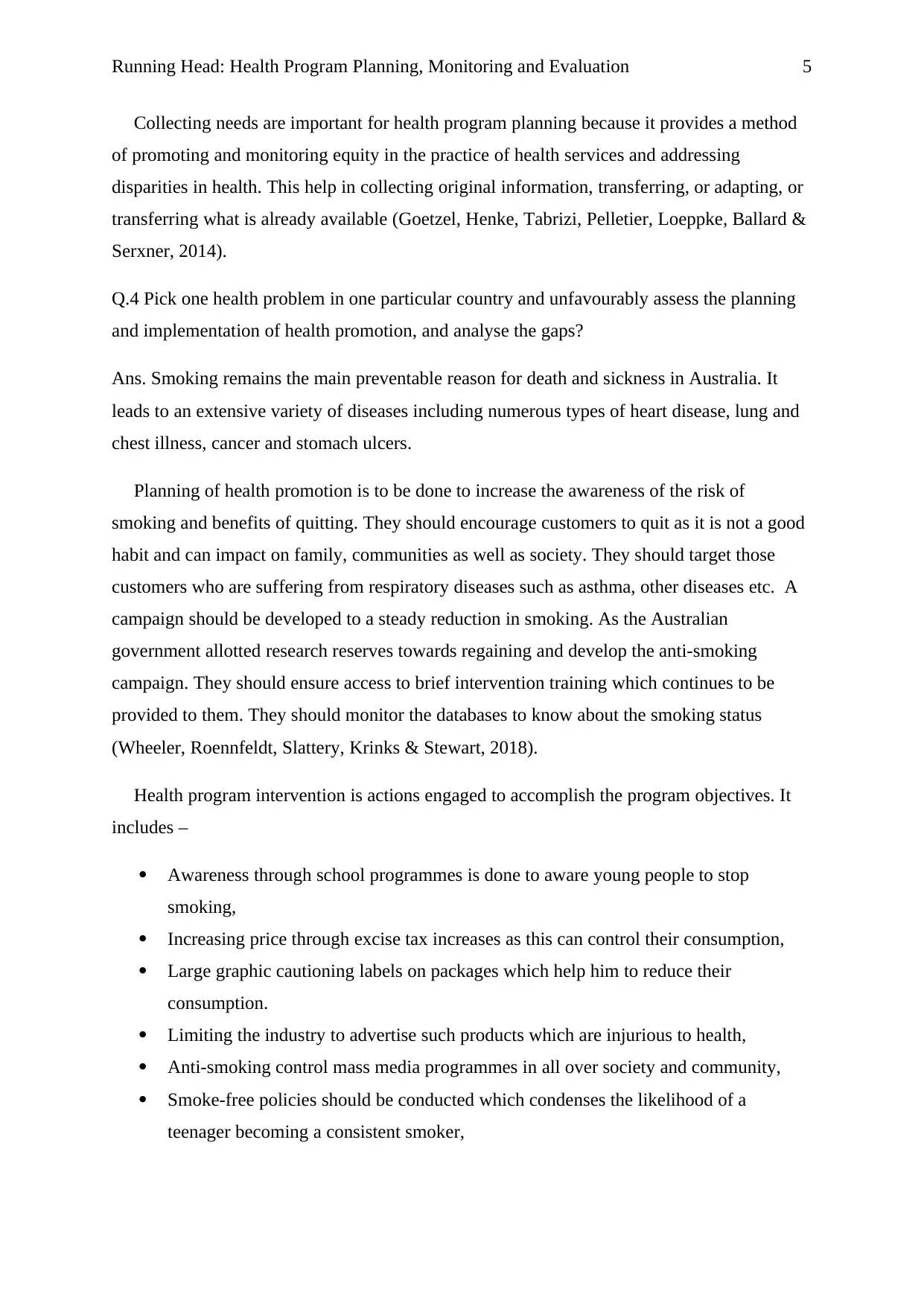
Running Head: Health Program Planning, Monitoring and Evaluation 5
Collecting needs are important for health program planning because it provides a method
of promoting and monitoring equity in the practice of health services and addressing
disparities in health. This help in collecting original information, transferring, or adapting, or
transferring what is already available (Goetzel, Henke, Tabrizi, Pelletier, Loeppke, Ballard &
Serxner, 2014).
Q.4 Pick one health problem in one particular country and unfavourably assess the planning
and implementation of health promotion, and analyse the gaps?
Ans. Smoking remains the main preventable reason for death and sickness in Australia. It
leads to an extensive variety of diseases including numerous types of heart disease, lung and
chest illness, cancer and stomach ulcers.
Planning of health promotion is to be done to increase the awareness of the risk of
smoking and benefits of quitting. They should encourage customers to quit as it is not a good
habit and can impact on family, communities as well as society. They should target those
customers who are suffering from respiratory diseases such as asthma, other diseases etc. A
campaign should be developed to a steady reduction in smoking. As the Australian
government allotted research reserves towards regaining and develop the anti-smoking
campaign. They should ensure access to brief intervention training which continues to be
provided to them. They should monitor the databases to know about the smoking status
(Wheeler, Roennfeldt, Slattery, Krinks & Stewart, 2018).
Health program intervention is actions engaged to accomplish the program objectives. It
includes –
Awareness through school programmes is done to aware young people to stop
smoking,
Increasing price through excise tax increases as this can control their consumption,
Large graphic cautioning labels on packages which help him to reduce their
consumption.
Limiting the industry to advertise such products which are injurious to health,
Anti-smoking control mass media programmes in all over society and community,
Smoke-free policies should be conducted which condenses the likelihood of a
teenager becoming a consistent smoker,
Collecting needs are important for health program planning because it provides a method
of promoting and monitoring equity in the practice of health services and addressing
disparities in health. This help in collecting original information, transferring, or adapting, or
transferring what is already available (Goetzel, Henke, Tabrizi, Pelletier, Loeppke, Ballard &
Serxner, 2014).
Q.4 Pick one health problem in one particular country and unfavourably assess the planning
and implementation of health promotion, and analyse the gaps?
Ans. Smoking remains the main preventable reason for death and sickness in Australia. It
leads to an extensive variety of diseases including numerous types of heart disease, lung and
chest illness, cancer and stomach ulcers.
Planning of health promotion is to be done to increase the awareness of the risk of
smoking and benefits of quitting. They should encourage customers to quit as it is not a good
habit and can impact on family, communities as well as society. They should target those
customers who are suffering from respiratory diseases such as asthma, other diseases etc. A
campaign should be developed to a steady reduction in smoking. As the Australian
government allotted research reserves towards regaining and develop the anti-smoking
campaign. They should ensure access to brief intervention training which continues to be
provided to them. They should monitor the databases to know about the smoking status
(Wheeler, Roennfeldt, Slattery, Krinks & Stewart, 2018).
Health program intervention is actions engaged to accomplish the program objectives. It
includes –
Awareness through school programmes is done to aware young people to stop
smoking,
Increasing price through excise tax increases as this can control their consumption,
Large graphic cautioning labels on packages which help him to reduce their
consumption.
Limiting the industry to advertise such products which are injurious to health,
Anti-smoking control mass media programmes in all over society and community,
Smoke-free policies should be conducted which condenses the likelihood of a
teenager becoming a consistent smoker,
⊘ This is a preview!⊘
Do you want full access?
Subscribe today to unlock all pages.

Trusted by 1+ million students worldwide
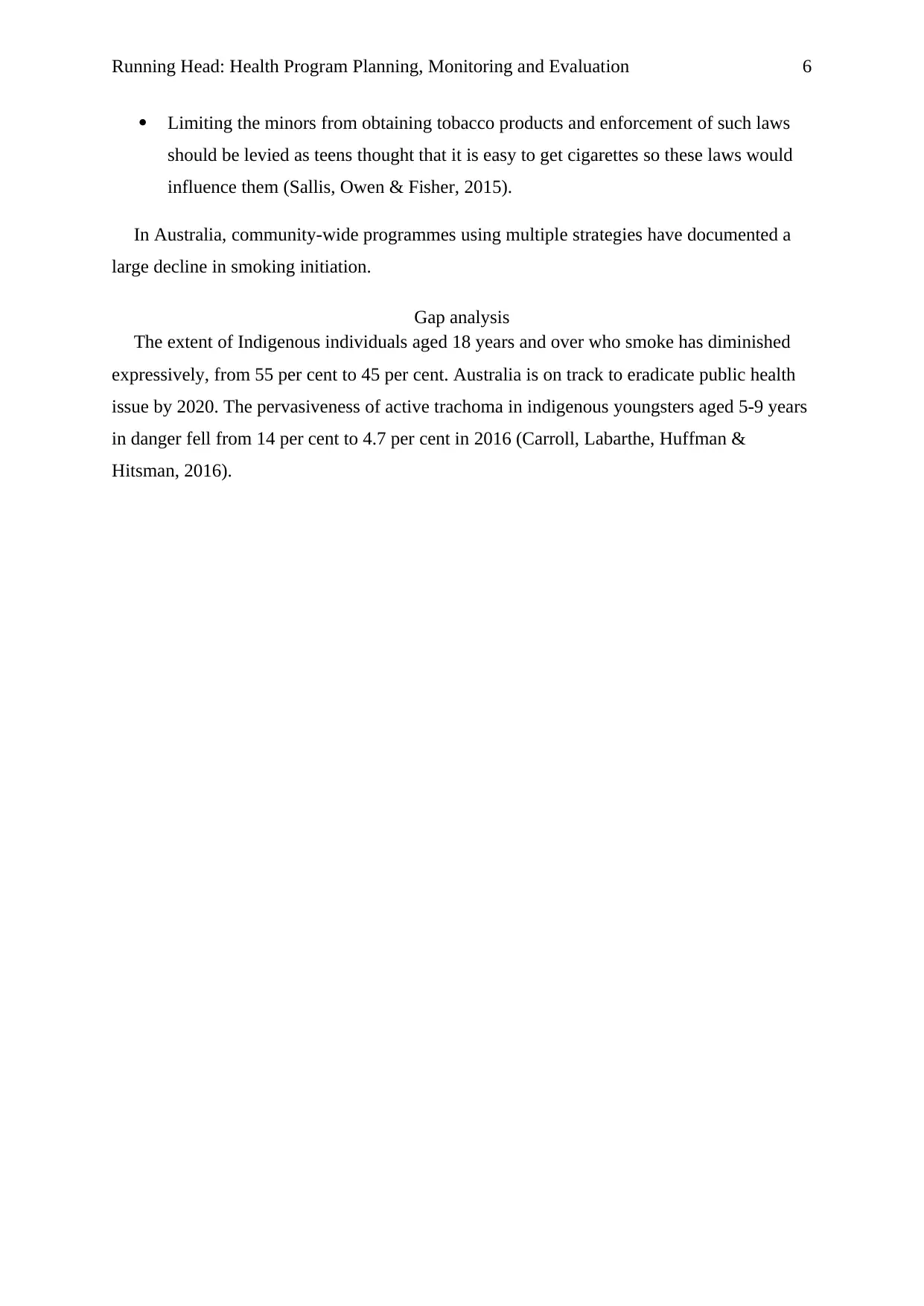
Running Head: Health Program Planning, Monitoring and Evaluation 6
Limiting the minors from obtaining tobacco products and enforcement of such laws
should be levied as teens thought that it is easy to get cigarettes so these laws would
influence them (Sallis, Owen & Fisher, 2015).
In Australia, community-wide programmes using multiple strategies have documented a
large decline in smoking initiation.
Gap analysis
The extent of Indigenous individuals aged 18 years and over who smoke has diminished
expressively, from 55 per cent to 45 per cent. Australia is on track to eradicate public health
issue by 2020. The pervasiveness of active trachoma in indigenous youngsters aged 5-9 years
in danger fell from 14 per cent to 4.7 per cent in 2016 (Carroll, Labarthe, Huffman &
Hitsman, 2016).
Limiting the minors from obtaining tobacco products and enforcement of such laws
should be levied as teens thought that it is easy to get cigarettes so these laws would
influence them (Sallis, Owen & Fisher, 2015).
In Australia, community-wide programmes using multiple strategies have documented a
large decline in smoking initiation.
Gap analysis
The extent of Indigenous individuals aged 18 years and over who smoke has diminished
expressively, from 55 per cent to 45 per cent. Australia is on track to eradicate public health
issue by 2020. The pervasiveness of active trachoma in indigenous youngsters aged 5-9 years
in danger fell from 14 per cent to 4.7 per cent in 2016 (Carroll, Labarthe, Huffman &
Hitsman, 2016).
Paraphrase This Document
Need a fresh take? Get an instant paraphrase of this document with our AI Paraphraser
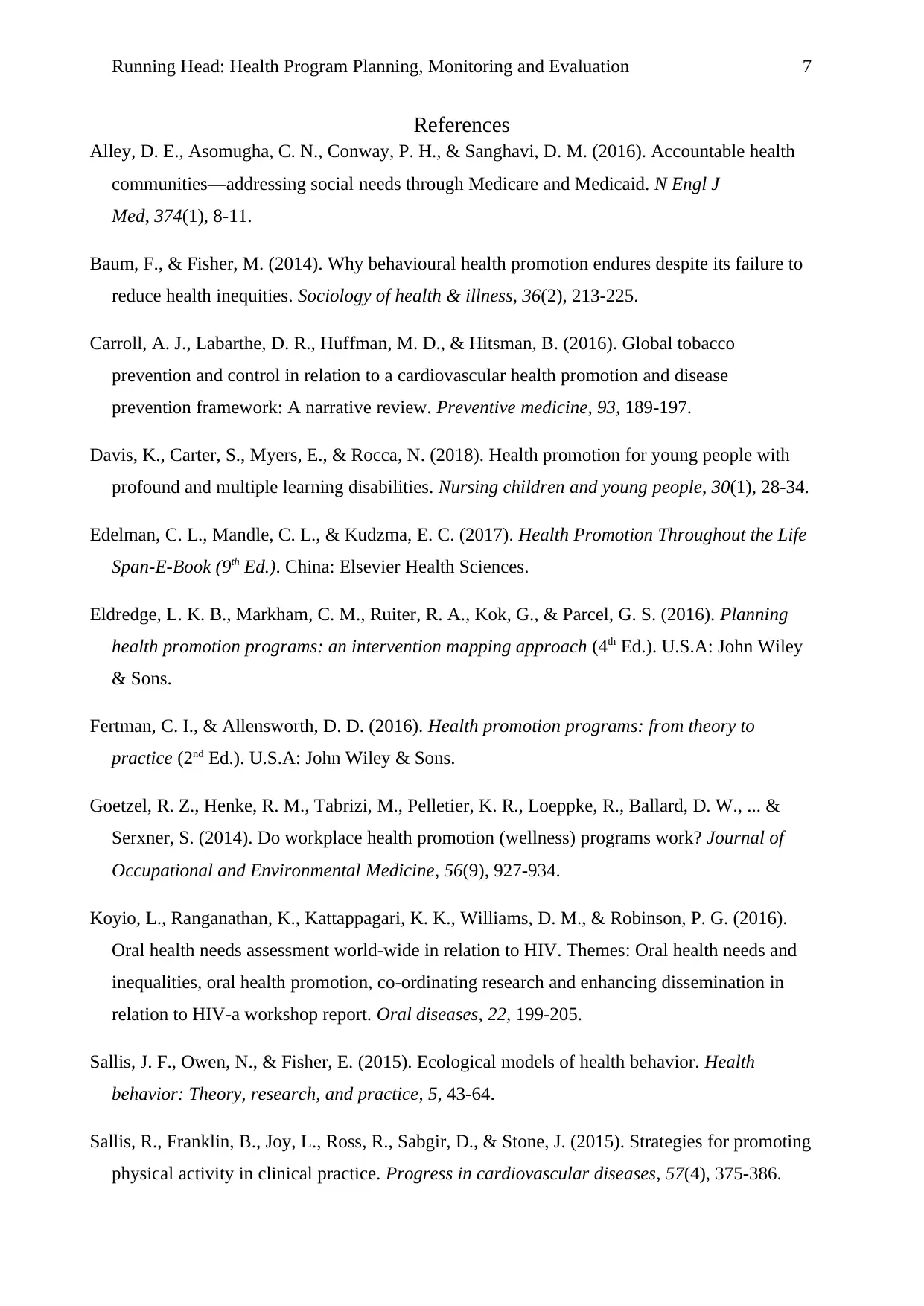
Running Head: Health Program Planning, Monitoring and Evaluation 7
References
Alley, D. E., Asomugha, C. N., Conway, P. H., & Sanghavi, D. M. (2016). Accountable health
communities—addressing social needs through Medicare and Medicaid. N Engl J
Med, 374(1), 8-11.
Baum, F., & Fisher, M. (2014). Why behavioural health promotion endures despite its failure to
reduce health inequities. Sociology of health & illness, 36(2), 213-225.
Carroll, A. J., Labarthe, D. R., Huffman, M. D., & Hitsman, B. (2016). Global tobacco
prevention and control in relation to a cardiovascular health promotion and disease
prevention framework: A narrative review. Preventive medicine, 93, 189-197.
Davis, K., Carter, S., Myers, E., & Rocca, N. (2018). Health promotion for young people with
profound and multiple learning disabilities. Nursing children and young people, 30(1), 28-34.
Edelman, C. L., Mandle, C. L., & Kudzma, E. C. (2017). Health Promotion Throughout the Life
Span-E-Book (9th Ed.). China: Elsevier Health Sciences.
Eldredge, L. K. B., Markham, C. M., Ruiter, R. A., Kok, G., & Parcel, G. S. (2016). Planning
health promotion programs: an intervention mapping approach (4th Ed.). U.S.A: John Wiley
& Sons.
Fertman, C. I., & Allensworth, D. D. (2016). Health promotion programs: from theory to
practice (2nd Ed.). U.S.A: John Wiley & Sons.
Goetzel, R. Z., Henke, R. M., Tabrizi, M., Pelletier, K. R., Loeppke, R., Ballard, D. W., ... &
Serxner, S. (2014). Do workplace health promotion (wellness) programs work? Journal of
Occupational and Environmental Medicine, 56(9), 927-934.
Koyio, L., Ranganathan, K., Kattappagari, K. K., Williams, D. M., & Robinson, P. G. (2016).
Oral health needs assessment world‐wide in relation to HIV. Themes: Oral health needs and
inequalities, oral health promotion, co‐ordinating research and enhancing dissemination in
relation to HIV‐a workshop report. Oral diseases, 22, 199-205.
Sallis, J. F., Owen, N., & Fisher, E. (2015). Ecological models of health behavior. Health
behavior: Theory, research, and practice, 5, 43-64.
Sallis, R., Franklin, B., Joy, L., Ross, R., Sabgir, D., & Stone, J. (2015). Strategies for promoting
physical activity in clinical practice. Progress in cardiovascular diseases, 57(4), 375-386.
References
Alley, D. E., Asomugha, C. N., Conway, P. H., & Sanghavi, D. M. (2016). Accountable health
communities—addressing social needs through Medicare and Medicaid. N Engl J
Med, 374(1), 8-11.
Baum, F., & Fisher, M. (2014). Why behavioural health promotion endures despite its failure to
reduce health inequities. Sociology of health & illness, 36(2), 213-225.
Carroll, A. J., Labarthe, D. R., Huffman, M. D., & Hitsman, B. (2016). Global tobacco
prevention and control in relation to a cardiovascular health promotion and disease
prevention framework: A narrative review. Preventive medicine, 93, 189-197.
Davis, K., Carter, S., Myers, E., & Rocca, N. (2018). Health promotion for young people with
profound and multiple learning disabilities. Nursing children and young people, 30(1), 28-34.
Edelman, C. L., Mandle, C. L., & Kudzma, E. C. (2017). Health Promotion Throughout the Life
Span-E-Book (9th Ed.). China: Elsevier Health Sciences.
Eldredge, L. K. B., Markham, C. M., Ruiter, R. A., Kok, G., & Parcel, G. S. (2016). Planning
health promotion programs: an intervention mapping approach (4th Ed.). U.S.A: John Wiley
& Sons.
Fertman, C. I., & Allensworth, D. D. (2016). Health promotion programs: from theory to
practice (2nd Ed.). U.S.A: John Wiley & Sons.
Goetzel, R. Z., Henke, R. M., Tabrizi, M., Pelletier, K. R., Loeppke, R., Ballard, D. W., ... &
Serxner, S. (2014). Do workplace health promotion (wellness) programs work? Journal of
Occupational and Environmental Medicine, 56(9), 927-934.
Koyio, L., Ranganathan, K., Kattappagari, K. K., Williams, D. M., & Robinson, P. G. (2016).
Oral health needs assessment world‐wide in relation to HIV. Themes: Oral health needs and
inequalities, oral health promotion, co‐ordinating research and enhancing dissemination in
relation to HIV‐a workshop report. Oral diseases, 22, 199-205.
Sallis, J. F., Owen, N., & Fisher, E. (2015). Ecological models of health behavior. Health
behavior: Theory, research, and practice, 5, 43-64.
Sallis, R., Franklin, B., Joy, L., Ross, R., Sabgir, D., & Stone, J. (2015). Strategies for promoting
physical activity in clinical practice. Progress in cardiovascular diseases, 57(4), 375-386.
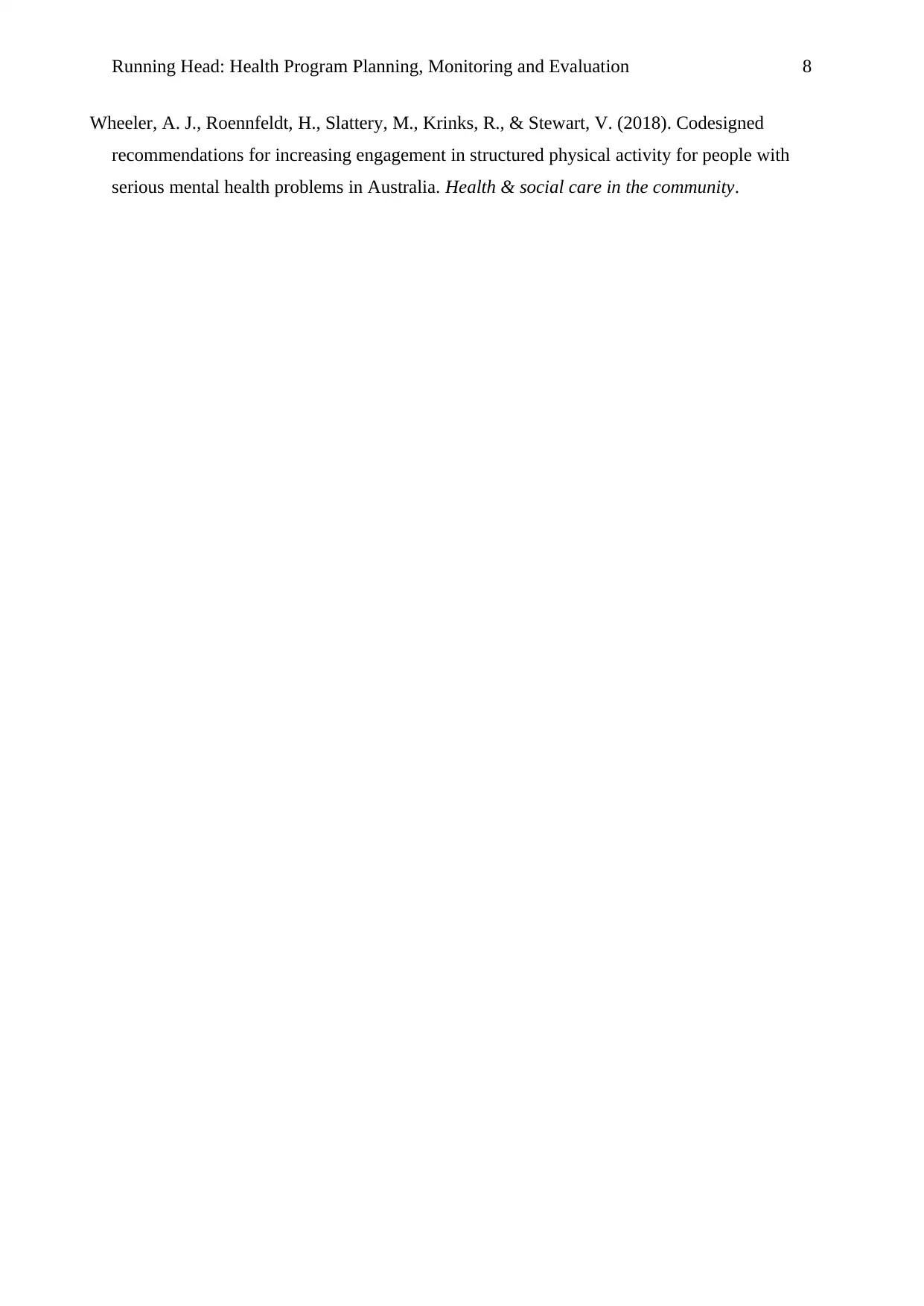
Running Head: Health Program Planning, Monitoring and Evaluation 8
Wheeler, A. J., Roennfeldt, H., Slattery, M., Krinks, R., & Stewart, V. (2018). Codesigned
recommendations for increasing engagement in structured physical activity for people with
serious mental health problems in Australia. Health & social care in the community.
Wheeler, A. J., Roennfeldt, H., Slattery, M., Krinks, R., & Stewart, V. (2018). Codesigned
recommendations for increasing engagement in structured physical activity for people with
serious mental health problems in Australia. Health & social care in the community.
⊘ This is a preview!⊘
Do you want full access?
Subscribe today to unlock all pages.

Trusted by 1+ million students worldwide
1 out of 9
Related Documents
Your All-in-One AI-Powered Toolkit for Academic Success.
+13062052269
info@desklib.com
Available 24*7 on WhatsApp / Email
![[object Object]](/_next/static/media/star-bottom.7253800d.svg)
Unlock your academic potential
Copyright © 2020–2025 A2Z Services. All Rights Reserved. Developed and managed by ZUCOL.




